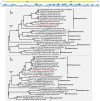Identification of novel mammalian viruses in tree shrews ( Tupaia belangeri chinensis)
- PMID: 38485510
- PMCID: PMC11017089
- DOI: 10.24272/j.issn.2095-8137.2023.306
Identification of novel mammalian viruses in tree shrews ( Tupaia belangeri chinensis)
Abstract
The Chinese tree shrew ( Tupaia belangeri chinensis), a member of the mammalian order Scandentia, exhibits considerable similarities with primates, including humans, in aspects of its nervous, immune, and metabolic systems. These similarities have established the tree shrew as a promising experimental model for biomedical research on cancer, infectious diseases, metabolic disorders, and mental health conditions. Herein, we used meta-transcriptomic sequencing to analyze plasma, as well as oral and anal swab samples, from 105 healthy asymptomatic tree shrews to identify the presence of potential zoonotic viruses. In total, eight mammalian viruses with complete genomes were identified, belonging to six viral families, including Flaviviridae, Hepeviridae, Parvovirinae, Picornaviridae, Sedoreoviridae, and Spinareoviridae. Notably, the presence of rotavirus was recorded in tree shrews for the first time. Three viruses - hepacivirus 1, parvovirus, and picornavirus - exhibited low genetic similarity (<70%) with previously reported viruses at the whole-genome scale, indicating novelty. Conversely, three other viruses - hepacivirus 2, hepatovirus A and hepevirus - exhibited high similarity (>94%) to known viral strains. Phylogenetic analyses also revealed that the rotavirus and mammalian orthoreovirus identified in this study may be novel reassortants. These findings provide insights into the diverse viral spectrum present in captive Chinese tree shrews, highlighting the necessity for further research into their potential for cross-species transmission.
中国树鼩( Tupaia belangeri chinensis)属于哺乳动物目(Scandentia),与灵长类动物有亲缘关系。它的神经、免疫和代谢系统与包括人类在内的灵长类动物相似,这使它在生物医学研究中被广泛用作一种有前景的实验模型,如癌症、传染病、代谢和精神疾病模型。在本研究中,我们使用宏转录组测序分析了105只健康树鼩的血浆、口腔和肛门拭子样本,以确定潜在的人畜共患病毒。我们共鉴定出8种具有完整基因组的哺乳动物病毒,属于6个病毒科:黄病毒科、肝炎病毒科、细小病毒科、小核糖核酸病毒科、光滑呼肠孤病毒科和棘突呼肠孤病毒科。我们首次报道了树鼩携带的轮状病毒。特别值得注意的是三种病毒——肝炎病毒1、细小病毒和小核糖核酸病毒——在全基因组范围内与先前报道的病毒表现出较低的遗传相似性(<70%),因此被认为是新病毒。其他三种病毒——肝炎病毒2、甲型肝炎病毒和戊型肝炎病毒——与已知病毒表现出高度相似性(>94%)。系统发育分析还表明,该研究中鉴定的轮状病毒和哺乳动物正呼肠孤病毒可能是新的重配株。这些发现为深入了解圈养中国树鼩携带的病毒谱提供了依据,这些病毒能否从树鼩跨物种传播给其他动物值得进一步研究。.
Keywords: Genomic analysis; Mammalian viruses; Meta-transcriptomic sequencing; Tree shrew (Tupaia belangeri chinensis).
Conflict of interest statement
The authors declare that they have no competing interests.
Figures






Similar articles
-
Decoding the virome reveals diverse novel viruses in tree shrews (Tupaia belangeri) in Yunnan Province.Virol Sin. 2025 Jun;40(3):314-323. doi: 10.1016/j.virs.2025.05.011. Epub 2025 Jun 1. Virol Sin. 2025. PMID: 40460917 Free PMC article.
-
Study of tree shrew biology and models: A booming and prosperous field for biomedical research.Zool Res. 2024 Jul 18;45(4):877-909. doi: 10.24272/j.issn.2095-8137.2024.199. Zool Res. 2024. PMID: 39004865 Free PMC article. Review.
-
Evaluating the phylogenetic position of Chinese tree shrew (Tupaia belangeri chinensis) based on complete mitochondrial genome: implication for using tree shrew as an alternative experimental animal to primates in biomedical research.J Genet Genomics. 2012 Mar 20;39(3):131-7. doi: 10.1016/j.jgg.2012.02.003. Epub 2012 Feb 18. J Genet Genomics. 2012. PMID: 22464472
-
Detection and genome characterization of two novel papillomaviruses and a novel polyomavirus in tree shrew (Tupaia belangeri chinensis) in China.Virol J. 2019 Mar 18;16(1):35. doi: 10.1186/s12985-019-1141-9. Virol J. 2019. PMID: 30885224 Free PMC article.
-
Tree shrew (Tupaia belangeri) as a novel laboratory disease animal model.Zool Res. 2017 May 18;38(3):127-137. doi: 10.24272/j.issn.2095-8137.2017.033. Zool Res. 2017. PMID: 28585436 Free PMC article. Review.
Cited by
-
Decoding the virome reveals diverse novel viruses in tree shrews (Tupaia belangeri) in Yunnan Province.Virol Sin. 2025 Jun;40(3):314-323. doi: 10.1016/j.virs.2025.05.011. Epub 2025 Jun 1. Virol Sin. 2025. PMID: 40460917 Free PMC article.
-
Isolation and identification of a novel porcine-related recombinant mammalian orthoreovirus type 3 strain from cattle in Guangxi Province, China.Front Microbiol. 2024 Jul 22;15:1419691. doi: 10.3389/fmicb.2024.1419691. eCollection 2024. Front Microbiol. 2024. PMID: 39104586 Free PMC article.
-
Surveillance and Genomic Evolution of Infectious Precocity Virus (IPV) from 2011 to 2024.Viruses. 2025 Mar 15;17(3):425. doi: 10.3390/v17030425. Viruses. 2025. PMID: 40143352 Free PMC article.
-
Study of tree shrew biology and models: A booming and prosperous field for biomedical research.Zool Res. 2024 Jul 18;45(4):877-909. doi: 10.24272/j.issn.2095-8137.2024.199. Zool Res. 2024. PMID: 39004865 Free PMC article. Review.
References
-
-
Amako Y, Tsukiyama-Kohara K, Katsume A, et al. 2010. Pathogenesis of hepatitis C virus infection in Tupaia belangeri. Journal of Virology, 84(1): 303–311.
-
-
-
Chen ZJ, Chen AY, Cheng F, et al. 2010. Chipmunk parvovirus is distinct from members in the genus Erythrovirus of the family Parvoviridae. PLoS One, 5(12): e15113.
-
MeSH terms
Associated data
LinkOut - more resources
Full Text Sources
